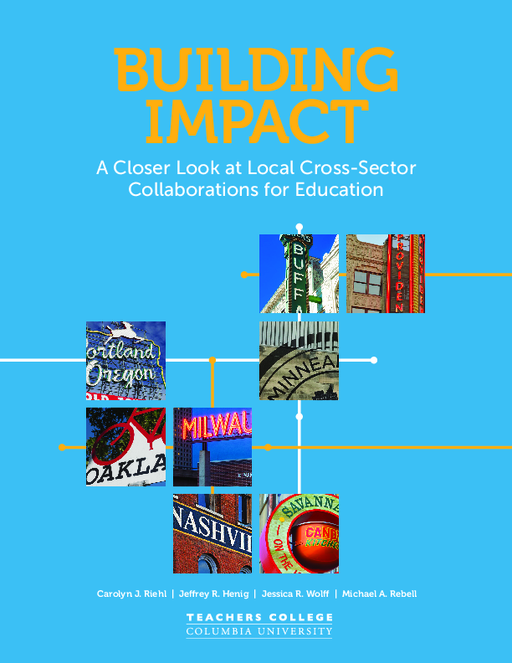Breadcrumb
- Wallace
- Reports
- Building Impact A Closer Look At...
Building Impact
A Closer Look at Local Cross-Sector Collaborations for Education

- Author(s)
- Carolyn J. Riehl, Jeffrey R. Henig, Jessica R. Wolff, and Michael A. Rebell
- Publisher(s)
- Teachers College, Columbia University
Summary
How we did this
Researchers conducted comparative case studies of eight collective impact education initiatives between 2015 and 2017. They conducted over 290 interviews and observations and gathered extensive documentation on the initiatives.
It takes a village to improve U.S. educational outcomes. More specifically, experts point to cross-sector collaborations, partnerships that can involve government, schools, business, universities, foundations, and nonprofits. Through this “collective impact”, a term coined in 2011, multiple parties team up to address issues too complex for one institution to solve on its own.
But does it work?
With that question in mind, Wallace commissioned Teachers College at Columbia University to produce a three-pronged study. This report is the third and final in the series. It presents the findings of research into eight collaborations from 2015 to 2017. The goal: To learn about how communities created and developed their initiatives.
Key Findings
Researchers did an in-depth study of three collaborations. They included Say Yes Buffalo, Milwaukee Succeeds, and All Hands Raised in Multnomah County, Ore. In addition, the research took a more limited look at five other initiatives. They were Alignment Nashville, Chatham-Savannah Youth Futures Authority, Northside Achievement Zone in Minneapolis, Oakland Community Schools, and Providence Children and Youth Cabinet.
The research revealed findings about important features, experiences, and challenges, including:
Start-up lessons
- A credible and compelling rationale. It provides the glue for bonding together the many different participants in a collaboration.
- Early champions and advocates. They can start and shepherd the process. Individuals can include local business executives, philanthropic foundation leaders, elected officials, educators, or community activists.
- A “cradle-to-career” vision of education. This helpsemphasize the value of providing coordinated support for young people from their early childhood through early adulthood and entry into the workforce. That was true even when the necessary resources weren’t fully in place.
Management
- A “backbone” organization. It coordinated and managed the partnership.
- Strong executives. Leaders created the connective tissue for the many collaboration members. Their effectiveness relied on creating relationships of trust with others.
- Public awareness and engagement efforts. They involved a variety of approaches ranging from large gatherings to websites and social media posts.
- A focus on data. It was used for continuous learning and feedback, coordination of services, and public reporting. But there were many obstacles, including privacy concerns and uncertainty about which metrics to use.
Strategic relationships
- Local school system partnerships. Several collaborations worked with school districts to develop high school academies, summer camps, and other initiatives.
- National support networks. They gave collaborations access to strategic ideas, program guidelines, technical support, and some funding opportunities.
Challenges
- Attitudes among school districts. Some saw collaboration as a distraction from their core goals.
- Marginalized groups. That involved finding effective ways to include such communities in the decision-making process
- Funding questions. Finding stable, long-term funding proved to be difficult.
- Unrealistic expectations. Many initiatives found that partners had unrealistically high expectations for outcomes.
- A slow start-up. The length of time it took for initial plans to be developed and implemented resulted in much slower start-up phases than many anticipated.
Looking Forward
The primary goal of the research wasn’t to evaluate outcomes. Researchers also suggested that the collaborations and networks required a longer period of time to show improved results.
At the same time, they concluded that the partnerships showed great potential for improving educational outcomes. “Most of the collaborations we studied seem to have helped calm often-contentious urban education politics and establish enough stability for partners to move forward,” they write.

Our research represents an attempt to lay the groundwork for a broad enterprise of additional research still to come.
Key Takeaways
- Collaborations need early champions and advocates and a compelling rationale.
- Cross-sector collaborations in education can serve a valuable function by promoting a “cradle-to-career” vision of education—even when they don’t have the resources to make it a reality.
- The start-up phase took longer than many anticipated.
- A “backbone” organization worked with the various players to coordinate and manage the partnership.
- Researchers suggested that the collaborations and networks required a longer period of time to show improved results.
Materials & Downloads
What We Don't Know
How successful were the initiatives ultimately?
How did the collaborations evolve?

